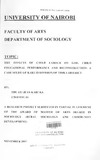| dc.description.abstract | This study discusses the effects of child labour on girl child
educational performance and reconstruction in Kakuzi Division, Thika
District. Child labour is illegal in Kenya; however, it still exists in various
places to date. The study noted that it has negative impact on the educational
performance of the girl child, but not much research has been done on the
extent of this influence. There was also need to ascertain the impact of the
family characteristics of the girl child labourer, the community's educational
initiatives towards the girl child labourer, the performance of the girl child
labourer in school and the extent of their educational reconstruction,
especially after the introduction of the free primary education scheme in
Kenya in 2003.
Literature review was done on the various aspects of the child labour
and girl child labourers such as their educational rights and children rights,
labour laws, past efforts towards improving the girl child educational
performances, and reconstruction of child labourers who had previously
dropped out of school, etc. In addition, the study reviewed literature on ~
Radical and Marxist feminist theories,
The study findings were collected through questionnaires and
interviews from a random sample of hundred (100) girl victims of child
labour between 10 and 17 years of age (forming the general respondents)
and twenty (20) key respondents that included teachers, local education
officials, provincial administration officials, parents, guardians, and Human
Rights Activists, who were purposively selected. They were then analyzed
using SPSS, statistical software, and reported through sets of percentages,
distribution tables, pie charts, bar and line graphs.
The study found out that the educational performances of the girls in
child labour are poorer than those not in child labour. The participation of
girls in child labour, the low educational performance of these girls and the
high school dropout rate (42%) were largely due to poverty. Most of the girl
child labourers have not adequately utilized the free primary education
scheme, as confirmed by the limited number of girl child labourers who had
previously dropped out of school going back.
Finally, the study recommends sensitization campaigns, policy formulation,
educational awareness of local Provincial Administration on the education of the girl child
labourer, and urgent need to curb cases of invisible!hidden child labour as practiced at the
individual households. In addition, financial support to girl child labourers through
sponsorships or bursaries,tuition waiver or free secondary education,especially for the poor,
and continuing free primary education with introduction of school uniforms is required to
control absenteeism. | en |

